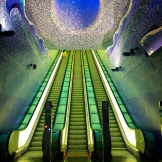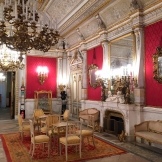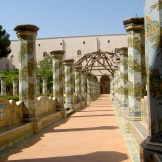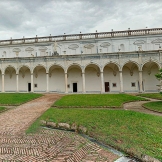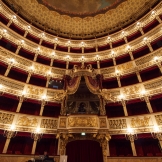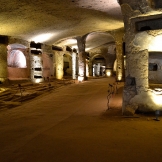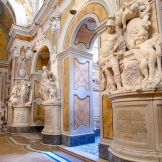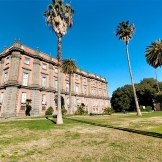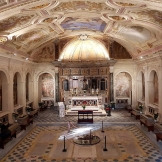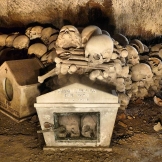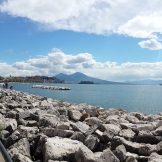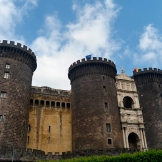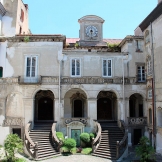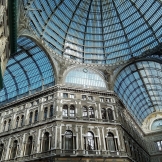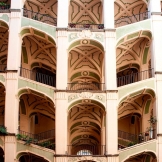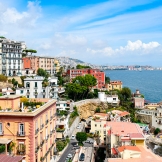Home > Порт "Naples/Pompeii, Italy"
Naples is a major Mediterranean port (cruise, ferry and cargo) located in the southern part of Italy, in the Campania region. The cruise port of Naples is located in the south of the city, next to the marina and ferry port.
Port address: Piazzetta di Porto, 80133 Napoli.
Terminals: Cruise ships dock at Molo Beverello next to the Stazione Marittima cruise terminal (4-level terminal near Castel Nuovo). Pier 21 and Pier 22 (North Pier) are also in use, with a shuttle bus service to the cruise terminal. The cruise terminal also includes a convention center, shopping center and office space.
Cruises with a visit to this port
How to get there
Attractions
Excursions
Reviews
 Wait a few seconds...
Wait a few seconds...
From Naples airport to port
Capodichino Airport is 6 km away. from Naples.
- You can take a taxi (€ 19)
- By bus to Piazza Garibaldi (Napoli Centrale train station). They leave every 15-20 minutes. The cost of the trip is 3 euros. Then take tram number 1 from the station to the final stop.
- You can also book a group transfer from the cruise company with the manager of For Gates Ukraine.
- The best way to order a transfer from the manager of For Gates Ukraine (55 Euro / 1-3 passengers).
From Rome airport to Naples
- There is a high-speed train from Roma Terminal to Napoli Centrale. The cost of the trip is 19 euros, and the travel time is 1 hour 10 minutes. If you buy a ticket on the day of departure, and not in advance, then the price is 43 euros.
- Order a transfer from the manager of For Gates Ukraine
From port to city
The cruise terminal is located in the city center, next to the Castel Nuovo castle. The main attractions are within walking distance. A bass tourist with a Russian audio guide runs around the city. The cost is 23 euros.
From Naples to Pompeii
Pompeii can be reached by the Circumvesuviana trains heading towards Sorrento from Porta Nolana train station. These trains also stop at Piazza Garibaldi near Napoli Centrale Station. Stop Napoli Garibaldi. You can find the station by going down into the underground of the central station and going all the way to the left. The station you want is called Pompei - Scavi Villa Misteri. The journey takes about 30 minutes. The cost is 3.2 euros.
There is also a Campania Express train running from 23 May to 15 October. It is a tourist route from Naples through Herculaneum and Pompeii to Sorrento. The fare is 15 euros. Departs from Piazza Garibaldi.
Mount Vesuvius. Classified as a stratovolcano, Mount Vesuvius dominates the horizon and landscape surrounding Naples and is a legendary volcano that erupted classically in 79 AD and caused the destruction and burial of Pompeii and Herculaneum.
Pompeii. Pompeii was an ancient city in the shadow of the iconic Mount Vesuvius, a very advanced and vast settlement that was destroyed at its peak during a volcanic eruption. Despite the reason for the devastation and the amount of lava that poured out on the city, Pompeii today is in a fantastic state - this is due to the huge layer of ash that settled on the partial ruins and thus acted as a preservative.Today you can visit Pompeii and walk through the vast ruins. Particularly interesting sights include the Amphitheater, Temple of Apollo and Temple of Jupiter.
National Archaeological Museum of Naples. Housed in a beautiful ornate building that dates back to the 1750s, served as a military and cavalry barracks and was converted into a museum in the following years. The museum is located north of the harbor, but there is a metro station next to the building. Inside you can find an extensive a collection that includes a wide range of Roman and Greek artifacts, as well as a selection of works from Pompeii and Herculaneum.
Catacombs of San Gennaro. Have you ever wanted to explore a secret underground world that contains a huge amount of details and passageways? This is exactly what the Catacombs of San Gennaro provide, and you can find the entrance to this otherworldly place near the Basilica del Incoronata in the northern part of Naples. Once underground, you will find a network of tunnels and passageways that are lined with tombs and crypts dating back to the ancient stories.
Herculaneum. Another city that was devastated after the eruption of Vesuvius in 79 AD was Herculaneum. Although the city was located further from Vesuvius than Pompeii, it was still completely destroyed. Herculaneum is considered a better preserved example than Pompeii, and still retains some of the wooden structures, frames and roofing. Interesting attractions within the complex include the Villa of the Papyri and Dom Argus, which both contain beautiful murals and wall paintings.
Castel Nuovo. Nuovo Castle stands out as a major feature of the Naples skyline and is one of the first landmarks to be seen by people entering the cruise ships. Located in close proximity to the famous Piazza del Plebiscito, the castle is easily accessible and is one of the main historical monuments in Naples. Established in 1282 , the castle has 5 round toothed towers and a fantastic triumphal arch, which was added later.
Chapel of San Severo. There are many chapels and churches in the heart of Naples, and the Chapel of San Severo is a really fine example. Established in 1590, the chapel was once the private building of the Duke of Torremaggiore and since 1613 has served as a family funeral chapel. Located in the center of Naples, the chapel is close to the harbor and Castel Nuovo. Contains a huge amount of art and several famous sculptures.
Castel del Ovo. When you enter the port of Naples, you will undoubtedly see this stunning sea castle. As the oldest surviving fortification in Naples, Castel del Ovo was built at the beginning of the 6th century BC and some forms of defenses have survived since then.
Piazza del Plebiscito. Undoubtedly, the main square of Naples, with the Royal Palace and the Royal Basilica, is a truly fantastic place to visit.This vast open space is filled with important buildings and statues, besides the aforementioned structures, it also contains the Palazzo Salerno, the prefectural palace and a statue dedicated to the Spanish king Charles III ...
San Domenico Maggiore. One of the beautifully decorated churches in Naples, founded by Dominican monks and built in 1324. The church is located in the center of Naples old town, close to the university and the Dante metro station. The church, full of Renaissance works, sculptures and ornaments, is extremely rich - the ceiling is gilded and the main altar is also a stunning masterpiece.
Neapolitan Cathedral. Dating back to the 13th century, it is a magnificent structure and serves as the main church in Naples and even in southern Italy. This religious building combines many styles, including Gothic, Renaissance and Baroque. This is due to the restorations and changes that have been made since its inception.
1) Car tour with a Russian-speaking guide - 4 hours
Meeting with the guide at the port of Naples, start of the excursion. An introductory story about the history of Naples, a visit to the Greco-Roman city: Piazza Gesu, spire of the Immaculate Virgin, Church of Santa Chiara, Church of Gesu Nuovo; a walk along the decumans (that is, three, ancient roads, broken at the end of the 6th century BC). Visit to Piazza San Domenico Maggiore, Sansevero Chapel Museum (entrance fee, extra charge). You will see the picturesque districts of the "folk" of Naples - San Gregorio Armeno street and the Cathedral, famous for the film "Operation Saint Januarius". The end of the excursion in the port of Naples.
Cost - on request
2) Car tour with a Russian-speaking guide + Pompeii - 6 hours
Inspection of Naples: a panoramic tour of the Pozliipo area with a stop and exit at the viewpoint, the sea areas of Mergellina, Riviera di Chiaia, Santa Lucia. Walking tour of the historical part of the city, inspection of the Plebiscite Square, the Royal Palace (outside); Basilica of San Francesco di Paolo (outside), Fortress of Sant Elmo and Monastery of San Martino (view from the square). Further - pl. Trieste and Trento, Artichoke fountain, Gambrinus cafe, Teatro San Carlo, Umberto Gallery, Fortress Anjou, pl. Municipio, monument to Victor Emmanuel of Savoy, Neptune fountain, Marine station.
Transfer to Pompeii (24 km), where an inspection of the archaeological zone will begin.
Sea gate, Temple of Apollo, Basilica, Forum, public buildings, market, Eumachia building, Temple of Vespasian, Macellum, antiquarium, Temple of Jupiter, House of the Tragic poet, Therma, Temple of Fortune Augustus, House of the Faun, Thermopoly, House of the Vettii, water supply, bakery, Lupanarium (brothel), Plenty Street, Palestra, Bolshoi Theater, gladiatorial barracks - all this can be seen in Pompeii.
Cost - on request
* Entrance tickets to Pompeii are additionally paid (on the spot at the ticket office for guides without a queue) - 12/15 euros / 1 person (the price depends on the additional exhibitions held)
Leave your comment
Comment

